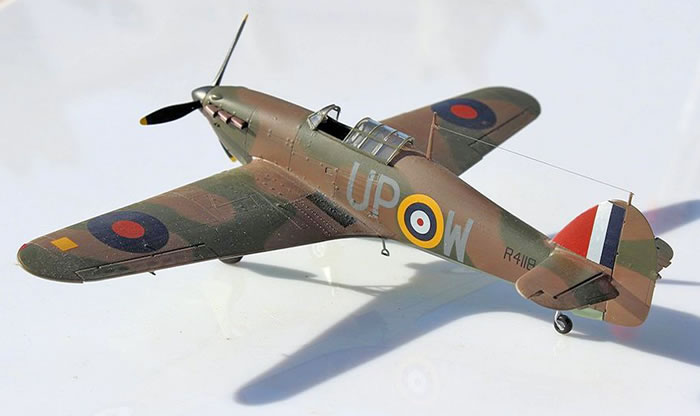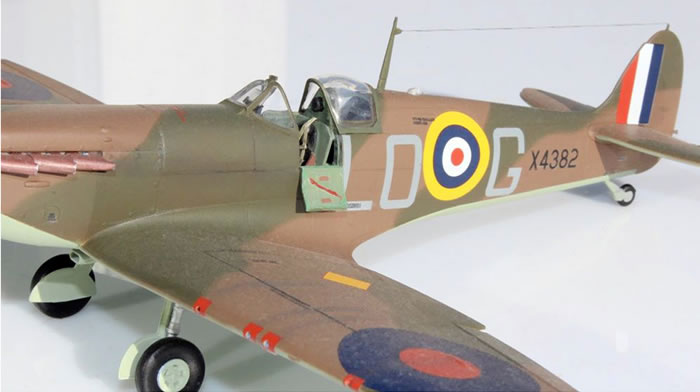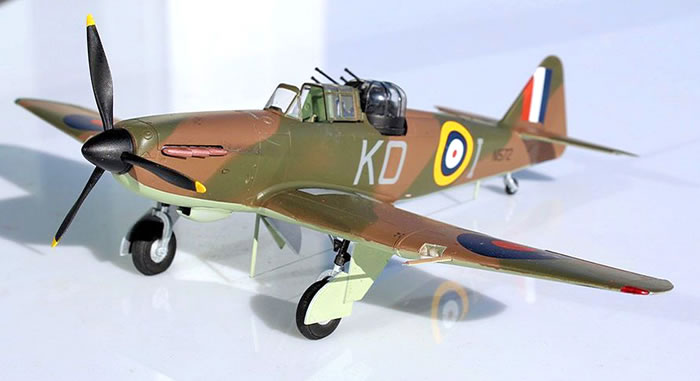Airfix 1/48 scale Spitfire Mk.I,
Hurricane Mk.I and Defiant Mk.I
Battle of Britain Trio
by Roger Hardy

Airfix's 1/48 scale Defiant Mk.I is available online from Squadron for only $25.99!
Background
Did you know that 4 out of 10 young people in the UK have no idea what the Battle of Britain was? True, apparently. Well, let’s start with summer of 1940. The Nazis had occupied most of central Europe which left only the UK shaking its fist from across the Channel. Its only allies were from the Commonwealth and the USA was neutral (although many volunteers joined the RAF). Hitler would have preferred an agreement with UK and had expected it whilst Neville Chamberlain was Prime Minister, but he had been replaced by Winston Churchill by popular demand. Even the US Ambassador, Joe Kennedy (father of JFK), strongly supported a truce with Hitler because he was certain that Britain couldn’t win a war against the Nazis.
Today, it is difficult to imagine that Churchill was then regarded as ‘yesterday’s man’ with the disaster of Gallipoli in WWI behind him and a reputation for political betrayal and whisky consumption. Although still an MP, he had been politically side-lined for almost twenty years and made his money writing books. He was 65, disliked and mistrusted in Westminster and even Buckingham Palace (The Duke of Windsor, formerly King Edward VIII, had strong fascist sympathies as did many of the ruling class. King George VI did not have much time for Churchill). However, Churchill was the guy to have on your side in a fight.

Blitzkrieg with rolling tanks and marching troops wasn’t going to work on an island so Hitler asked the Head of the Luftwaffe, Hermann Göring to wipe out the Royal Air Force from the air and leave the country open for invasion by sea. He confidently agreed, the plan being to destroy the airfields and the aircraft on the ground. However, the Luftwaffe wasn’t designed for this kind of warfare; it was a tactical force intended to support an advancing army and they weren’t used to the tenacity of the defenders or their numbers (the Luftwaffe intelligence had seriously under-estimated the strength of the RAF). Their Messerschmitt Bf109E fighters were short-ranged and had limited duration when over UK, but the German aircraft still outnumbered the RAF aircraft by three-to-one. The battle raged for 112 days, from mid-July to the end of October when the Luftwaffe licked its wounds and switched its attention to bombing cities, giving the RAF a chance to rebuild. In that time, the Luftwaffe lost almost 1900 aircraft, around half of its strength; the RAF just over 1000 but had more aircraft at the end of the conflict than at the beginning because of Lord Beaverbrook’s concentration on aircraft production in every factory he could find.
This was the Nazis first failure but it proved to be decisive because it left the UK free to be the base for the eventual D-Day invasion which could never have happened if the Battle had been lost.
If you haven’t seen it, this 1969 film is a must-see: https://en.wikipedia.org/wiki/Battle_of_Britain_(film). Group Captain Hamish Mahaddie scoured the world for the film’s real stars; the aircraft! It’s wonderful to see all of those Hurricanes, Spitfires, Messerschmitts and Heinkels in the air! Real aircraft, not CGI! Most are still flying on the warbird circuit.
The RAF warriors who fought this battle numbered only 3,000. Over 500 didn’t make it. On the German side, their aircrew losses were 2500. The RAF pilots were not just British; many were from other countries such as Czechoslovakia, Netherlands, France, Belgium, Poland, South Africa, Canada, USA, Australia and New Zealand and it is important to recognise the contribution that everybody made to the immense effort involved to protect Britain from invasion and allow the continuation of the fight against the forces of fascism.
‘Never before in the field of human conflict was so much owed by so many to so few.’
In the Box
These have all been reviewed in the box by Brett Green:
http://www.hyperscale.com/2015/reviews/kits/airfix05126reviewbg_1.htm
http://www.hyperscale.com/2015/reviews/kits/airfix05127reviewbg_1.htm
http://www.hyperscale.com/2016/reviews/kits/airfix05128reviewbg_1.htm
Because the build experience of each of these models is so similar, I decided to review them as a set and all three look as if they are the products of the same Airfix team. I built them straight-from-the box using the kit decal options, as I usually do.
The cockpit interiors would be perfectly acceptable in 1/32 scale so you need to add little except seat belts if you’re not using the crew members supplied. I wouldn’t even bother with p/e instrument panels except on the Defiant because the others are barely visible and the decals look perfectly good.

It soon becomes clear that the fit of the parts of these models is very precise and that they are the products of computer-aided design but remember that real plastic bends and can be squeezed whereas CAD components cannot; computers don’t understand ‘wiggle room’. This means that if you’ve got something not-quite-right in the assembly, something else won’t fit properly further down the line. If you’ve been careful, you end up with a model that needs no filler whatsoever.
Surface detail is fine for me but some may think the engraved lines a little deep. There is some raised detail as well.
I like the fact that, ahead of the windscreen, the nose top is usually one part so that you don’t have the normal seam. This is nice because each aircraft has a prominent fuel tank filler cap on the nose and this means that the detail does not get destroyed when you fettle the seam, ‘cos there ain’t no seam!
I like the separate control surfaces which allow you to pose them and they look more realistic than engraved joints because the fit is so snug. The flaps are not separate which is a shame.
The plastic is a little brittle and my kits had some of the finer components broken on the sprue (aerial mast on Hurricane and undercarriage retraction strut on the Defiant). They can also break fairly easily if you are not careful with the side-cutters and, because they are so fine, it’s difficult to repair them.

Another nice touch is the massive number of options offered for the canopies, open or closed. So, for closed canopies it is one piece, for open canopies the sliding part is slightly larger to fit over the fixed parts. Your spares box says ‘thank you’!
The Spitfire has all of the Mk I, II and V variations and the Defiant has every option for canopy and turret, which can also be posed open. Very nice. The turret of the Defiant is a perfect little model in its own right.
I painted the models using Tamiya acrylics sprayed with a Chinese copy of a Badger, which is actually very nice. The model was glossed up for decalling with Tamiya rattle-can semi-gloss then the complete model sprayed with flat varnish, again, courtesy of Tamiya.
The decals are perfect but a little brittle and tend to resist bending. This is only a problem on the Hurricane where the red patches over the gun ports will not conform around the leading edge of the wing. I found that I could fix it to the upper surface and wait for the decal to set, then coax it round the leading edge with some Microset. I used Microsol afterwards and this worked just fine. The only alternative is to paint them. The fin flashes also stand proud of the fin leading edges but can be coaxed to follow the surface with a little patience.
There’s not much point doing much weathering because these aircraft were mostly quite new and had been repainted early in 1940, plus the Battle took only 4 months and it was a good summer. I used some Humbrol weathering powder for the exhaust staining and a little scuffing with a silver pencil but nothing more.
In summary, all three models are straightforward builds with no problems and can be recommended without reservation as probably the best in this scale. They help cement New Airfix back at the top of the game. Well done.
Model, Images and Text
Copyright ©
2017 by Roger Hardy
Page Created 23 February, 2017
Last Updated
23 February, 2017
Back to HyperScale Main Page
|
Home
| What's New | Features | Gallery | Reviews | Reference | Resource Guides | Forum |